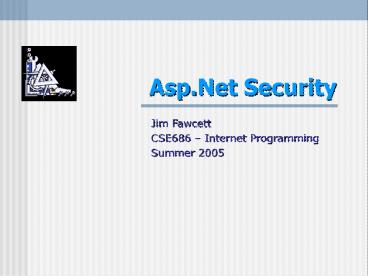Asp.Net Security PowerPoint PPT Presentation
Title: Asp.Net Security
1
Asp.Net Security
- Jim Fawcett
- CSE686 Internet Programming
- Summer 2005
2
Security Model
- Authentication
- Who do you say you are? User id
- Do you have proof? Password
- Authorization
- Do you have the priviledges to do a requested
action?
3
Asp.Net Authentication
- Asp.Net directly supports three models
- Authentication mode None
- Application supplied security
- Authentication mode Windows
- Based on Windows Accounts
- Suitable only for local network
- Authentication mode Forms
- Manged by application with support for
redirection and accessing identities provided by
Asp.Net - Authentication mode PassPort
- Authentication credentials stored on Microsoft
server - Sites license the service
4
No Asp Supplied Authentication
- Asp.Net allows all users access to all asp pages
- It is up to the application to provide
authentication and authorization - Authentication and Role-based access provided by
user control(s). - Application uses session to tell if user is
logged in. - User signs in and is assigned roles from database
by user control. - Access to pages based on roles.
- No help from Windows doing this.
5
No Authentication
- Virtual directory allows anonymous access
- Web.Config file specifies
- ltauthentication modeNone/gt
- ltauthorizationgt ltallow users/gtlt/authoriza
tiongt - Its up to application to provide authentication
- CSE686 Labs have encouraged you to build
authenticating control and provide your own
redirections.
6
Security Settings for None
7
Windows Authentication
- Uses custom socket ports, as well as port 80, so
wont go through firewalls. - Requires all users to have Windows accounts on
server. - Suitable only for site serving a local network.
- Remote access requires operation in a domain or
Active Directory with Kerberoshttp//support.mic
rosoft.com/default.aspx?scidkben-us324276http
//support.microsoft.com/default.aspx?scidkben-us
810572
8
Windows Authentication
- The major advantage of Windows Integrated
Authentication is that you can use all of the
Windows role-based security mechanisms. - Its easy to restrict access to a page to one or
more roles and roles can be configured with
specific permissions.
9
Security Settings for IWA
10
Forms Authentication
- Application provides login page.
- Asp.Net takes care of redirections.
- Application provides id and password storage and
retrieval. - Almost no help with role-based access.
- Can configure directories, using web.config files
to accept or deny non-authenticated users - ltdeny users?/gt // anonymous users
- ltallow users/gt // allow all others
11
Forms Authentication
- Virtual directory allows anonymous access
- Web.Config file specifies
- ltauthentication modeForms/gt ltforms
loginUrllogin.aspxgt ltcredentials /gt
lt/formsgtlt/authenticationgt - ltauthorizationgt ltdeny users?/gtlt/authoriz
ationgt - Application provides login.aspx which uses
System.Web.Security.FormsAuthentication to
redirect after authentication. - Application uses database to store and retreive
user ids and passwords. - Can logout using FormsAuthentication.SignOut()
12
Security Settings for Forms
13
Passport Authentication
- Fee-based service provided by Microsoft
- Wont be discussed further
14
Role-Based Security without Windows
- Public web sites will almost certainly use
Application supplied or Forms based
authentication. - Clients will not have a user account on the
server, so Windows role-based security is no
help. - The site may need to define at least simple
roles - New user
- Registered user
- Premium member
15
Role-Based Authorization
- So how do you provide role-base access?
- At login, retrieve users roles from db and store
in session. - Provide control on each page that specifies
allowed roles. - OnPageLoad, check user roles from session against
allowed roles from control. - Probably easiest to do this with custom
authentication but workable with Forms Auth. - Would help to have an administrators page to add
users and define roles and role membership.
16
Security Issues
- Authentication v
- Who are you?
- Authorization v
- What are you allowed to access?
- Confidentiality
- Hiding content in volatile environment
- Integrity
- Detecting modification
17
Encrypted Channel with SSL
- Secure Sockets Layer provides an encrypted
channel for transmitting sensitive data. - Recognized by most browsers.
- Used by all the major sites Amazon,
- Uses 128 bit encryption.
18
Secure Sockets Layer (SSL)
- Requires third party certificate
- You generate a certificate request file using web
server certificate wizard. - Send to certificate authority, Verisign, along
with a check for 349 (renewed each year for
249). - Wait for about three weeks.
- Install the certificate using the web server
certificate wizard. - You can generate certificates used only for
development.
19
Requiring SSL
- SSL is invoked whenever the url prefix is https.
- You can force users to use SSL by setting
directory properties.
Virtual directory properties page allows you to
require SSL if you have installed a certificate.
20
Using .Net Encryption
- You may need to encrypt password files or other
sensitive information stored on your site. - System.Security.Cryptography
- Public Key (asymmetric) algorithms
- DSA DSACryptoServiceProvider
- RSA RSACryptoServiceProvider
- Private Key (symmetric) algorithms
- DES DESCryptoServideProvider
- Triple DES, RC2, Rijndael
21
Using .Net Hashing
- You may need to ensure that messages or files
have not been tampered with. - System.Security.Cryptography
- 128 Bit Hash
- MD5 MD5CryptoServiceProvider class.
- 160 Bit Hash
- SHA1 SHA1CryptoServiceProvider
22
References
- Asp Applications Authentication
- Programming .Net, Jeff Prosise, Microsoft Press,
2002 - Applications, Authentication, SSL
- ASP.NET Unleased, Second Edition, Stephen
Walther, SAMS, 2004

